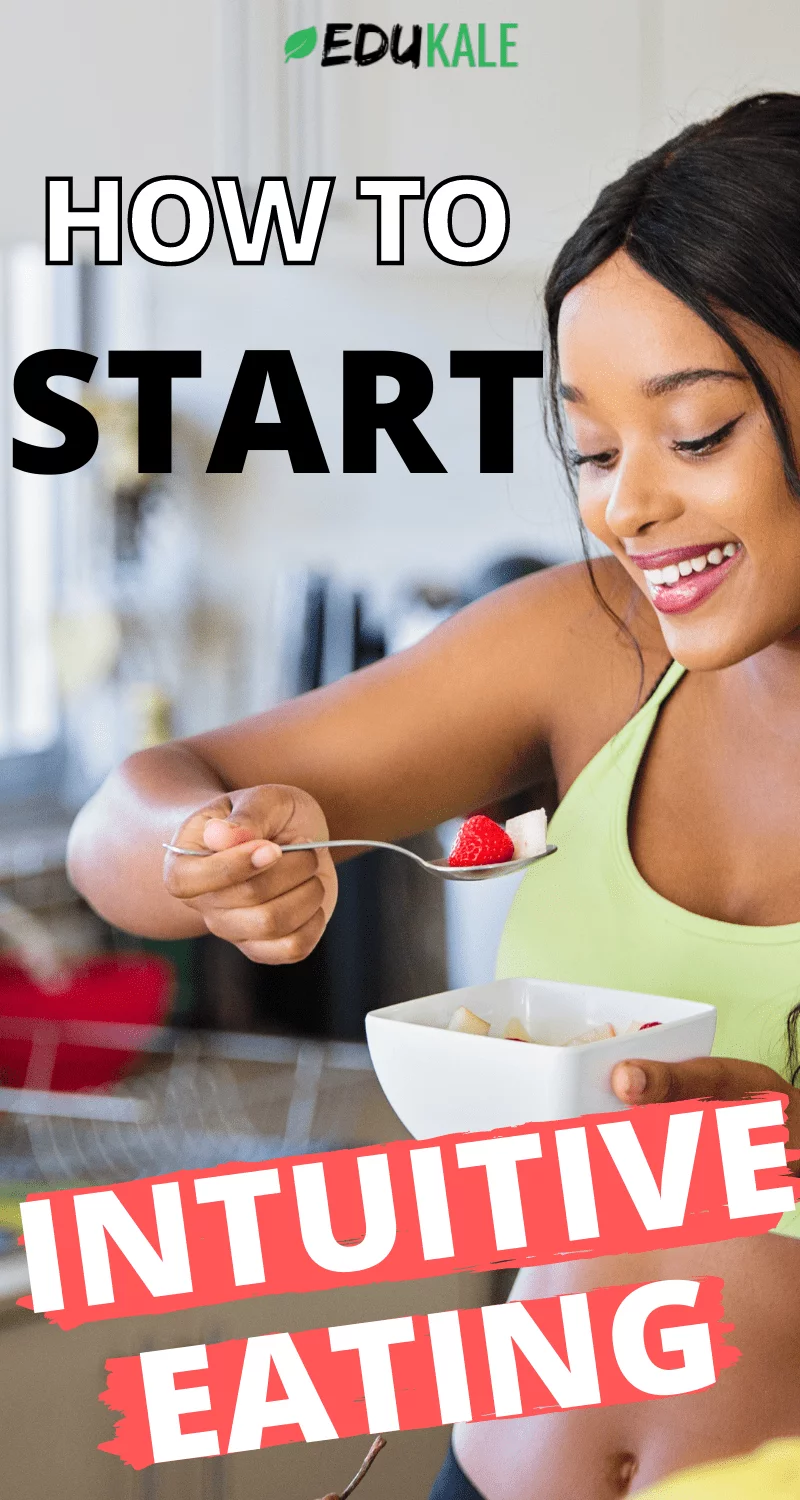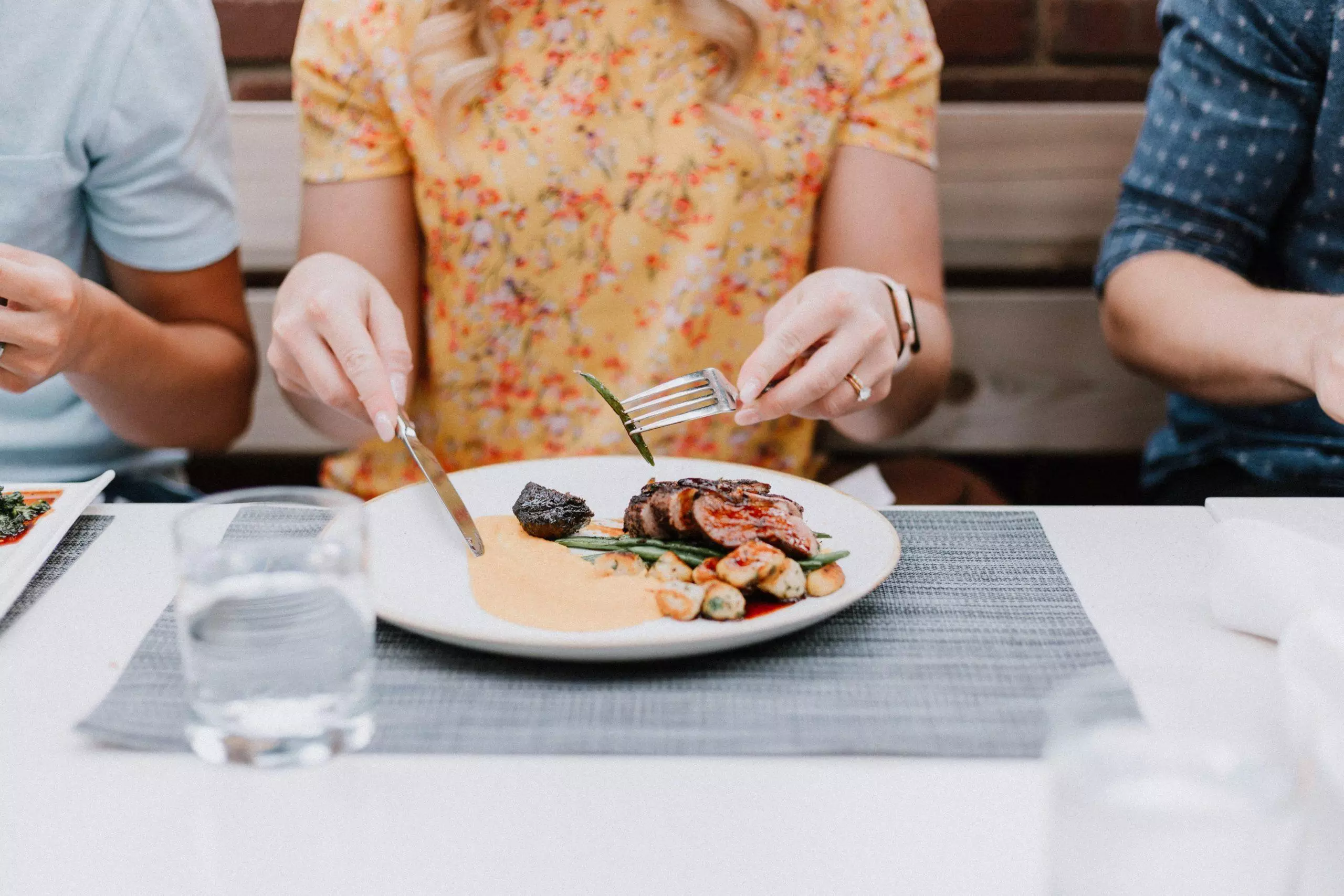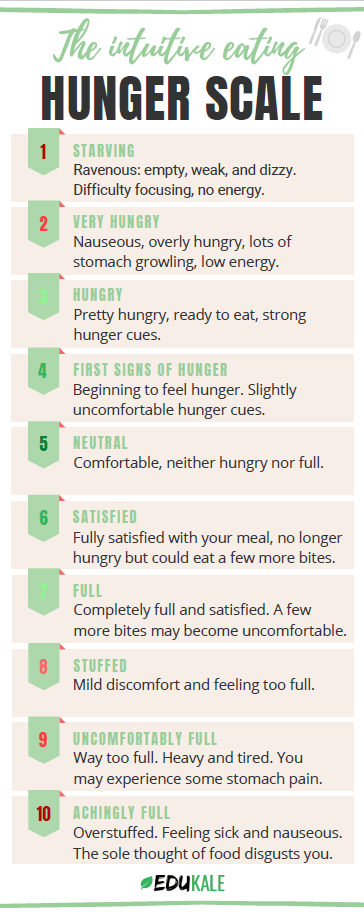This post contains affiliate links from which I may receive a small commission, at no extra cost to you. In no way does this affect my opinion or the information I provide on the product. Please read my disclaimer for more info.
The practice of intuitive eating has been blowing up these past years, and for a good reason.
People are tired of spending their time counting their calories, tracking their macros, and playing yo-yo with their weight. They’re sick of dieting and feeling deprived by eating plans that just don’t work.
They want to learn to honor their body and put their health first. This is where intuitive eating comes it.
But when you’re just starting out, it can be pretty hard to grasp the concept of intuitive eating and to know which steps to take. So if you’re wondering how to start intuitive eating, this article is for you!

What is intuitive eating?
Intuitive eating is an evidence-based way of eating that promotes a healthy relationship with food. It focuses on your body’s internal hunger and fullness cues instead of outside rules and restrictions.
It was created by two dieticians, Evelyn Tribole and Elyse Resch. Intuitive eating is a personal process of honoring your health by listening to your body’s signals in order to meet your needs [1].
It is NOT a diet or food plan but rather a way of life that aims to free you from harmful diet culture.
It’s based on ten principles, which involve honoring your hunger and fullness cues, making peace with food, respecting your body, and putting your health first.
If you want more information on what intuitive eating is before you start, you can check out the other articles I wrote on the subject:
- What is intuitive eating and is it for everyone
- The intuitive eating hunger scale
- How to eat intuitively during the holidays

How to start intuitive eating.
So now you know what intuitive eating is, you feel like it may be a good fit for you and you want to try it out, but you have absolutely no idea where to start? Here are the steps I recommend you follow if you are a beginner to intuitive eating.
- Learn about intuitive eating.
Reading this article is already a great step in the right direction!
While you’re starting out with intuitive eating, I highly recommend documenting yourself on it. It’s important to learn from various sources to get a few different points of view so you can find what works best for you.
Evelyn Tribole and Elyse Resch have a book on intuitive eating, that you can get here.
If you’re not familiar with the nutrition basics and have no idea what a healthy and balanced meal is, I would also recommend documenting yourself on that. I have a beginner’s guide to healthy eating here.
I know some people don’t share this point of view and think that healthy nutrition has little place in intuitive eating, but I don’t see them as incompatible at all!

- Work on your relationship with food.
This step would need an article of its own— having a healthy relationship with food is fundamental to build good eating habits and to eat intuitively.
Society tends to push us towards diet culture and losing weight at all costs instead of creating healthy and sustainable food habits. If you are still in the diet mentality when you try intuitive eating, it can’t work.
As I’ve mentioned previously, intuitive eating is not just another diet. While it may result in weight-loss, it should never be your main goal.
I highly suggest ditching the diet mentality and all-or-nothing thinking, learning how to stop feeling food guilt, and breaking free from food obsession or eating addiction.
You also need to stop seeing foods as inherently good or bad. Labeling foods as bad will only make you crave them more. While some foods are undeniably healthier than others, all foods can be good depending on the situation.
An ice-cream sundae will definitely help curb your emotional hunger after a long, hard week, while spinach leaves will not. And vice versa if you’re looking for a salad base when craving a fresh, healthy lunch.

Here are a few articles I wrote that can help you with these issues:
- How to ditch diet culture
- Dangers of the all-or-nothing mentality
- How to deal with food guilt
- How to end food obsession
- How to stop binge-eating
- How to stop extreme hunger
- How to stop eating addiction
- Learn to use the hunger and fullness scale.
To my mind, the most important component of intuitive eating is being in tune with your hunger and fullness cues. After years of dieting (or excessive eating!) and completely disregarding these cues, it can be really difficult to know what hunger and satiety feel like.
In order to learn how to reconnect with these signals, I suggest using the hunger and fullness scale. It’s a tool that helps you be more in tune with your body’s signals and enables you to self-regulate.
The goal is to position your hunger level on the scale before, during, and after each meal. The scale goes from 1 to 10, 1 being ravenous, 10 being achingly full, and 5 being a neutral middle ground. Check out my article on the hunger and fullness scale if you’re interested in learning more.

- Eat mindfully.
An important aspect of intuitive eating is also to eat mindfully. Mindful eating is a technique used to regain control over your eating habits. It means being aware of what you eat, and eating consciously in a healthy and balanced way in order to rediscover taste, flavor, and pleasure.
The goal is to listen to what your body needs and to know when you are hungry and when you are full. Mindful eating involves listening to your hunger cues. It means eating slowly, taking the time to chew, and noticing the different textures and flavors of your food.
Eating should be done without any distractions, focused on appreciating your food. Here’s more information on how to practice mindful eating if you’re interested.
- Eat the foods your body craves.
As a child, your body used to be very good at telling you what you wanted or didn’t want, when to eat and when to stop eating.
But after a lifetime of focusing on outside rules, of eating because people were telling you to, and of being bombarded by diet culture, it may seem hard to trust your body today.
The good news is, this can change. You need to give yourself permission to eat the foods that you want when you crave them. As your body will learn that it has access to these foods whenever it wants, cravings, binges, and overeating will decrease.
If you feel like this is overwhelming, you can start out by reintroducing one food item that you love but that you prevent yourself from having. Allow yourself to enjoy this food whenever you please.
After a while, the novelty factor will wear off and you won’t crave it as much anymore. You can then introduce a new food item, and keep going until you have no “off-limit foods” anymore.
Once you get to this point, it will be easy for you to eat what your body craves. If you feel like having creamy milk chocolate, have the chocolate. If you feel like having a nice fresh salad, have the salad. Little by little, your body will be able to give you the right signals and push you towards the foods it needs.

- Stop listening to the opinions of others.
The goal of intuitive eating is to be able to listen to your own wants, needs, and hunger and fullness cues.
This means that other people’s opinions should have no place whatsoever in your eating plans. I have seen so many people feel pressured to finish their plates or to put down the extra slice of cake because of what others had to say.
I know this can be difficult, but you need to be comfortable enough in your food choices that what others think of them don’t matter. This can look like saying no to your grandma who’s pressuring you for second helpings when you don’t want anymore.
It can be eating the cookie you crave for dessert even if you feel your colleagues judging you. It can look like turning down dessert because it’s not something you particularly enjoy.
People should never comment on your food choices. But if they do, stand your ground in a calm but firm manner, and simply disregard their opinion.

- Practice gentle nutrition.
As a nutritionist, I won’t tell you that it doesn’t matter if you eat only junk food and have a vegetable every other month. It is still important to have some general nutrition notions and to work towards healthy and balanced eating.
I honestly believe that if you combine all of the previous tips, you will naturally find the right balance between eating healthy, nutritious meals and honoring your cravings.
It’s very important to take a step back from any specific meal and look at the bigger picture. One junk-food meal won’t break your health, and one kale salad won’t make it.
It’s pointless to feel guilty if you didn’t listen to your hunger cues for one meal or if you pushed yourself to eat something you didn’t want once. It’s all about the bigger picture, meaning healthy, intuitive eating, and a great relationship with food.
It’s also important to be flexible with yourself: you won’t always be in the correct setting for mindful and intuitive eating. You won’t always be able to eat exactly what you’re craving. This is fine, it’s all about doing the best you can in the situation you’re in. Any progress towards that is great progress!

How to start intuitive eating in conclusion.
Intuitive eating is an evidence-based way of eating that promotes a healthy relationship with food by focusing on your body’s internal hunger and fullness cues instead of outside rules and restrictions.
It involves honoring your physical signals, making peace with food, respecting your body, and putting your health first.
If you’re looking to start intuitive eating, I suggest working on your relationship with food, learning to eat mindfully, using the hunger scale, eating the foods your body craves without listening to others, and practicing gentle nutrition.
-Lucie

